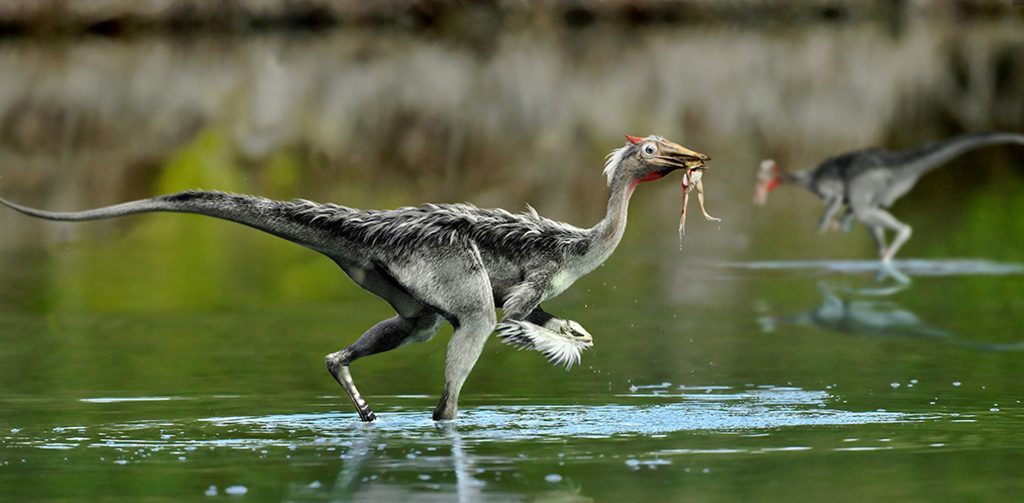Early dinosaur breathed like a bird
Bavarian State Collection for Palaeontology and Geology
Pelecanimimus polyodon from the Lower Cretaceous (125 Ma) is the first predatory dinosaur found in Spain. An international team of paleontologists now discovered features on the fossil that are typical of dinosaurs closely related to birds, as well as birds. The researchers published their findings in the prestigious British journal Zoological Journal of Linnean Society.
Pelecanimimus polyodon belongs to a group of bipedal dinosaurs called Ornithomimosauria (“bird imitating lizards”), its body structure resembles that of modern ostriches. Pelecanimimus is the earliest representative of the group found in Europe.
New analyses of the Pelecanimimus fossil show features typical of dinosaurs closely related to birds, as well as birds: Pelecanimimus is the only ornithomimosaur that preserves an ossified sternum. Its morphology is similar to the sternums of other dinosaurs closely related to birds, such as velociraptors or oviraptors, and primitive birds. Moreover, Pelecanimimus is the only known representative of this group with so-called uncinate processes. These small, hook-shaped bones are associated to the ribs and are also present in extant and extinct birds. Researchers assume that uncinate processes are related to the breathing apparatus because they are insertion areas for intercostal muscles, whose function is moving the ribs and sternum.
“The fact that Pelecanimimus preserved these processes suggests that it also had a bird-like breathing mechanism,” said Elena Cuesta, lead author of the study. “Apparently, the origin of such avian-like features is older and more widespread than thought. However, the evolutionary history of both the ossified sternum and uncinate processes is still unclear. Nevertheless, their detection in Pelecanimimus confirms that these elements were present in Ornithomimosauria as well as in other dinosaurs.”
The Spanish-Japanese team of paleontologists, including Elena Cuesta, a postdoctoral researcher at the SNSB-Bayerische Staatssammlung für Paläontologie und Geologie (SNSB-BSPG), also discovered distinctive features on the fossil’s hands. Pelecanimimus has conspicuously elongated metacarpals and phalanges, a feature also found in some later ornithomimosaur species. Therefore, the authors of the study identified and named a new group within the ornithomimosaurs: the Macrocheiriformes, which means “forms with large hands.”
The dinosaur Pelecanimimus polyodon dates from the Lower Cretaceous (125 Ma) and was discovered back in 1993 at the Las Hoyas fossil site in Spain. Preserved are the anterior half of an articulated skeleton with complete skull as well as soft tissue. The new analysis of the fossil now gives the researchers new insights into the early evolution of the group Ornithomimosauria. They compared their data on Pelecanimimus polyodon with other fossil finds belonging to this dinosaur group from the last three decades.
Publikation:
Elena Cuesta, Daniel Vidal, Francisco Ortega, Masateru Shibata, José L Sanz, Pelecanimimus (Theropoda: Ornithomimosauria) postcranial anatomy and the evolution of the specialized manus in Ornithomimosaurs and sternum in maniraptoriforms, Zoological Journal of the Linnean Society, 2021, https://doi.org/10.1093/zoolinnean/zlab013
Kontakt:
Dr. Elena Cuesta
Bavarian State Collection for Palaeontology and Geology (SNSB-BSPG)
Richard-Wagner-Str. 10, 80333 Munich
Tel.: +49 (0)89 2180 6644
E-Mail: cuesta@snsb.de
Reconstruction of Pelecanimimus polyodon (Artist: José Antonio Peñas Artero)


